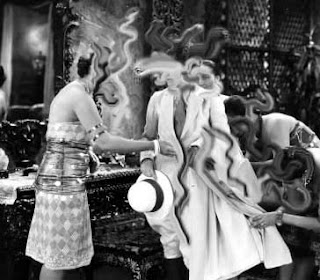
I recently got a look at Lizabeth Scott for the first time watching DEAD RECKONING (1947), a classic film noir co-starring Bogart as a soldier home from WW2 who runs into intrigue while looking for a missing buddy in a small midwestern city. As the fine foxy femme (possible) fatale, Scott seems tailored to look and sound as much like Bacall as possible, and that's spooky, yo.
The uncanny frisson moment comes when Bogart first lays eyes on Scott; he's been a long time without a friend to lean on here in this unfriendly town and now in the ubiquitous swanky gambling joint wherein songs are sung in husky sorrowful sexy voices and incriminating letters hidden it doesn't seem he'll ever find one. We first see her from behind, facing the bar as he approaches; her long wavy, Bacall-style hair is in her eyes when she turns and Bogie seems to be very confused. Is this is his wife, Lauren Bacall?
Then, Humphrey hears the stranger's purring, low cat-like voice and he seems to relax, like one does when they finally find someone they know at a strange party. She may not be his real life wife, but she's close enough - any port in a storm.
Watching the film for the first time I, too, thought - whoa, it's Bacall in disguise. As Lizabeth Scott's face slowly appears out of the mist of lighting and hair, we share Bogart's bizarre frisson, an experience many of us have when-- for brief spans of time when tired or in a strange town-- everyone we see looks like composites of other people we know. When that 'lost and alone in a crowd' vibe starts to get you, the mind plays tricks, and people look like people you want them to be.
This works for me too because I am always getting this film mixed up with DARK PASSAGE, which Bogie and Bacall made that same year, and which has a phonetically similar (and thematically ambiguous) title.
The duplicitous nature of the Scott's character works perfectly with this uncanny frisson and the film becomes an uneasily oscillating romance as Bogie repeatedly tests Scott's sincerity and pledges his love, only to have suspicion-raising events counter trust-raising events, keeping him forever uncertain.
In this way, the film is incredibly contemporary: the whole idea of "living happily ever after" or escaping the confines of the workaday world, leaving sins behind in a romantic rush becomes less and less imaginable the farther one gets away from the war. In a foxhole a soldier can dream of home and not have to be disappointed that home ain't what it used to be. Once home in normal old America the soldier must find a new fantasy to sustain him through the hard times. These characters want to roll the credits while they're in the chips, but the film keeps unspooling until not a single chip is left, just like in real fuckin' life.
It's a very odd film, derivative even, with whole stretches seemingly cribbed from MALTESE FALCON, THE BIG SLEEP and GILDA. The derivation is part of the paranoid deja vu that infuses Bogart's uncertain glances. Who hasn't fallen for someone just because they look and sound like another person we loved once long ago (or in Bogie's case, in his last two pictures?) Not only that, but who amongst us hasn't made promises to be loyal and trust a person forever only to realize a mere month later they're a rat. They don't measure up, but then again, neither do you, and it's all just a crazy mixed up world, ruled by icy chameleons like the fetching Scott, who can switch acting gears on a poisoned dime and leave even the hard-boiled likes of Bogart reeling like a drunk at twilight.





